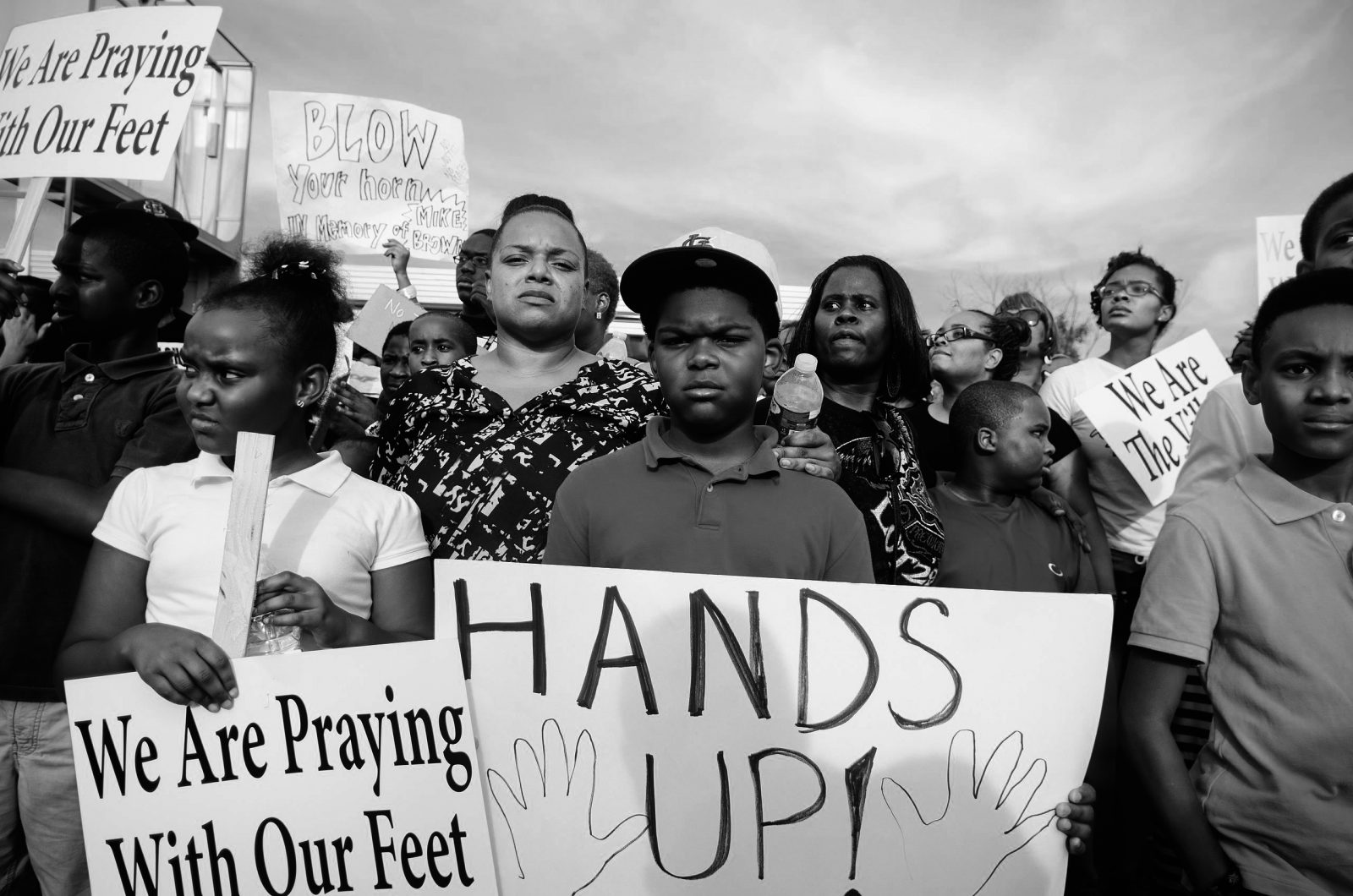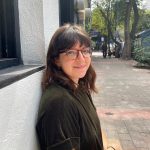Ten years ago, police officer Darren Wilson killed Michael Brown in Ferguson, Missouri, sparking protests that reverberated across the country and around the world. It was the summer after I graduated from high school in New Jersey. Eighteen years old, I was the same age as Brown when he was murdered. I had been volunteering with an organization in Camden, New Jersey, that was working to end mass incarceration, and I was newly into phrases such as “social justice” and “criminal justice reform.” When one of my best friends asked my opinion on the looting in Ferguson, I said something like, “Of course I believe in Black Lives Matter and the right to protest—but not like this.” He pushed back: Who was I to say not like this?
That question and what the Ferguson uprisings laid bare—the myth of “bad apple” police officers, the extent of police militarization—formed the first cracks in my belief in criminal justice reform. Together, they planted the seed that, over the next few years, led to me becoming an abolitionist.

From the series
Ferguson at Ten
How the police killing of Michael Brown a decade ago propelled the modern decarceral movement.
Ferguson was at the heart of my abolitionist journey. Still, when I began talking with Daven McQueen, Inquest’s assistant editor, about the idea of writing an essay for Inquest’s series marking one decade since the Ferguson uprisings, I hesitated. The essay’s frame was about the role Ferguson had played in shaping the activist imaginations of those of us young enough to have experienced the uprisings as a true coming-of-age moment, and I struggled over if and how I could articulate the story of my own growth as, in some way, speaking to the experiences of a generation. In my life and activism, I try to prioritize listening, so I felt hesitant to speak for others, much less a generation.
The approach I’ve opted for here echoes memoir, presenting a series of vignettes that explore how what happened in Ferguson is stitched, like embroidery thread, through my own activism. I hope it will inspire others in my generation to undertake similar reflections about their own paths toward abolition in a post-Ferguson world.
In the summer of 2016, in college and still optimistic about the possibilities of criminal justice reform, I interned at the National Initiative for Building Community Trust and Justice. The project intended to improve police–community relations, but in reality almost all the funding went to police departments. Every day, I took notes on calls with police chiefs, but I barely saw interactions with community leaders or organizers. I felt disillusioned: Why are we listening to police more than community members?
Early that July, police killed Philando Castile in Minneapolis–St. Paul and Alton Sterling in Baton Rouge. Something in me shifted: reform would never be enough, I knew. I left the internship able to articulate something the program never intended to teach—an idea which Ferguson had first planted: Police reform, which pours money into police forces at the expense of investing directly in communities, is not the solution and is often actively harmful. So, I committed to activism by and for directly impacted community members.
Returning to Providence to continue school, I started volunteering with the grassroots group Direct Action for Rights and Equality (DARE), which aims to remove reentry barriers for those returning from incarceration. I learned immensely from the community organizers who led DARE, as I fought for and with the people most impacted by the harms of mass incarceration. We successfully lobbied the Providence Housing Authority to remove application and eviction policies that discriminated against people with criminal records. We ran campaigns to validate job licensing certificates that people earned while incarcerated, and to eliminate solitary confinement in Rhode Island. By seeing each initiative tackle yet another way that the prison system surveils and punishes poor communities of color, I learned what prison abolition is really about: building safe communities with access to quality housing, health care, employment, and education.
Meanwhile in college, I majored in Urban Studies to better understand the intersections of race, class, and resources. I took courses on street art and the use of public space, on gentrification and policing, on the vulnerability of communities at the water’s edge. I read Angela Y. Davis’s Are Prisons Obsolete? and Ruth Wilson Gilmore’s Golden Gulag.
I also sought joy and intimacy in anti-prison work. For several years, I DJed a hip hop and R&B radio show called The Gentle Touch. As it is often difficult to visit incarcerated loved ones and exorbitantly expensive to call them, listening to the radio offers a means of communication. (Earlier in the year, Inquest screened Sylvia Ryerson’s film Calls from Home about a similar program that reaches prisons in Appalachia.) For three hours every Sunday night, I received phone calls and text messages from people with significant others in prison or jail. I’d record their phone call or read aloud their text, making sure the dedication—please tell them I love them, I miss them, to keep their head up—led into the song they requested. Mail arrived from people who were incarcerated, and I read their messages aloud on air, too. It was sexy and joyous, with moments of hurt and heartbreak. Abolition is about strengthening community and relationships, and the music strengthened the connections that prisons try to tear apart.
After college, I found myself reflecting on Ferguson again, and particularly on the harm of the “but not like this” narrative. I had come to understand that it criticizes those resisting oppression while ignoring the violence of the oppressor. This came up again in 2020, when liberals denounced looting in response to George Floyd’s murder but couldn’t bring themselves to say, without qualification, that Black Lives Matter. This, of course, is part of how power maintains its grip. We saw it again after October 7, when people condemned Hamas while neglecting to acknowledge Israel’s ongoing occupation and apartheid.
And I experienced it in Mexico City, where I moved in 2022 to improve my Spanish. It manifested as people criticizing feminists who spray-painted monuments to protest high rates of femicide, while having little to say about the femicide itself. I noticed it as well when, as part of a language class presentation, I presented Devin Allen’s photograph of Baltimore protesters climbing onto a cop car and smashing its windshield after Freddie Gray was murdered in 2015. I almost didn’t include the photo, knowing the class might fixate on it. I was right. So, I became the one asking: Who are we to say not like this?
In Mexico, there is no established abolition movement. Nearly everyone I asked about it while I was living there cited drug trafficking, disappeared persons, and gender-based violence as barriers to imagining a society without prisons. Almost no one trusts the police, who are known for corruption. Still, most calls for change in Mexico are carceral. At the International Women’s Day march each year, demands for justice for femicide victims overwhelmingly ask for a punitive solution: Lock him up! It was a challenging and powerful context in which to struggle with my own abolitionist commitments. I grappled with how I could, without giving up my goal of abolition, accept that the movement might not look the same in Mexico—that people who grew up there might understand their own needs differently, and that U.S. abolition might not map neatly onto the Mexican context. By following my commitment to listen to community members, the abolitionist questions became clearer: What would it take for Mexican communities to be safe? What social services, culture shifts, reductions in wealth inequality would we need to create? How do we talk about open borders, freedom of movement, and the option to stay? In other words, how do we work toward the long-term goal of radical freedom while acknowledging that the short-term steps might look different?
And, of course, there is Palestine. I’m an anti-Zionist Jew. In Mexico City, I organized with the group Judíes por una Palestina Libre, which formed in the aftermath of October 7. I grew up attending Hebrew school one evening per week, and I had my bat mitzvah at age twelve. Similar to how I criticized the looting in Ferguson before I became an abolitionist, I used to say: “I just think we can support the state of Israel without supporting the actions of the current Israeli government, you know?” Then, I learned that my synagogue’s fundraiser for planting olive trees in Israel existed because Israel destroyed Palestine’s olive trees in the first place. A whole set of belated realizations tumbled after. I learned about the degrading Israeli checkpoints for Palestinians. I learned that in 2007, Israel imposed a brutal blockade on Gaza, effectively creating an open-air prison for more than 2 million people. (I already knew that around 2 million people are incarcerated in the United States.) I learned that Palestinians had tweeted advice to Ferguson protesters about how to deal with tear gas. I read Davis’s Freedom Is a Constant Struggle. I thought of the ways police officers in the United States are encouraged to use violence as a first resort against Black people, and how Zionism convinces IDF soldiers to see all Palestinians as a threat. Making connections, I understood that abolition here requires a free Palestine. As Davis makes clear, they are in fact the same struggle.
Abolition is about transforming society so everyone can live safe, just lives. Abolition is about addressing issues at their root. No one should get to say “but not like this” without discussing Israel’s violent repression of peaceful Palestinian protests like the Great March of Return in 2018. No one should get to say “but not like this” without acknowledging the violence of the blockade in Gaza, of settler colonialism in the West Bank, of the ongoing Nakba. I reject the right to insist “but not like this” from the outside. I am interested only in understanding, exposing, and eradicating the underlying factors: histories of racism and violence against Black people in the United States and against Palestinians in occupied Palestine.
As Ruth Wilson Gilmore reminds us, “where life is precious, life is precious.” Police shootings do not make life precious. Mass incarceration does not make life precious. Israel’s genocide of the Palestinian people does not make life precious. Abolition—building safe communities with access to quality housing, education, employment, and health care, with rehabilitative rather than punitive methods for addressing interpersonal harm—makes life precious. One decade ago, the Ferguson uprisings sparked this understanding for me. I am grateful that they set me on my path toward becoming an abolitionist. May we remember Michael Brown, Sonya Massey, and all the Black people killed by police violence in the United States. May we fight for a free Palestine. And may we build a world without police and prisons, full of precious lives.
Image: Joe Brusky/Flickr

